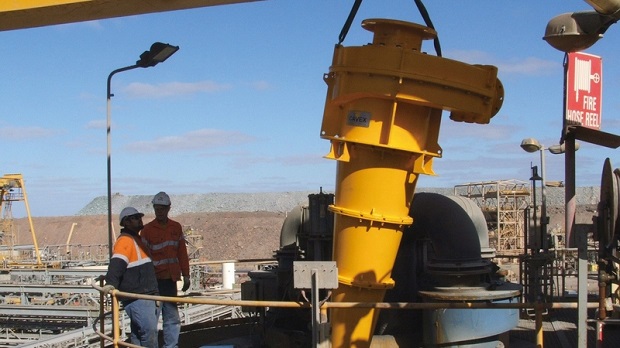
Maintaining the classification of a hydrocyclone in a grinding mill closed circuit can be challenging. Mark Schmidt, Product Manager for Weir Minerals Canada, offers his advice for resolving the most common problems encountered.
When a customer calls to tell me they’re having trouble with their hydrocyclones, it’s almost always about the classification of the hydrocyclone in their mill grinding circuit. Sometimes the hydrocyclones aren’t meeting the performance classification objectives, other times a different classification target is required.
Whatever your goal, over nearly four decades of working with hydrocyclones at mineral processing operations around the world, it’s clear there’s no substitute from a deep understanding of the steps required to improve the performance of hydrocyclone clusters in a closed circuit with the grinding mill.
Manipulating water and pressure
The primary ways the plant metallurgist can change or alter the hydrocyclone’s classification is to vary the cyclone feed dilution water or adjust the hydrocyclone’s operating pressure.
Producing a finer classification in hydrocyclones requires additional dilution water to lower the feed density of the cyclone, and is also achieved by raising the hydrocyclone’s operating pressure. Obtaining a coarser classification requires a reduction of dilution water to the cyclone feed sump and can also be accomplished by reducing the cyclone operating pressure.
To alter the classification, many people try changing a hydrocyclone’s fittings, such as the apex (spigot) or the vortex finder. While fitting changes do influence the hydrocyclone’s performance, simply adjusting the feed dilution water and cyclone operating pressure is generally considered a more effective way to make a meaningful change to the classification.
Understanding the apex and underflow density
The primary function of an apex in the cyclone is to control the amount of water traveling with the solids leaving the cyclone through the underflow. Best practice is to minimise the amount of water travelling in the underflow, as this reduces the amount of fines by-pass to the mill.
In primary mill circuit base metal operations, hydrocyclones should be set up to produce underflow densities in the range of 50-55% by volume. Producing dilute cyclone underflow densities can lead to over grinding in the mill, translating to pay metal (product) recovery losses in flotation.
Operating cyclones with apex diameters that are too small can lead to cyclone plugging and roping.
Managing vortex finders
While the use of different sized vortex finders does affect classification, its impact on changing the classification can be of less influence than adjusting the hydrocyclone feed dilution water or operating pressure.
A primary purpose of vortex finder selection is to configure the hydrocyclone to handle a specific volume of feed slurry, at a specific operating feed pressure. Changing the vortex finder allows pressure to be maintained despite changes in the volume of feed slurry.
Most global cyclone manufacturers will generally provide a range of four to six different sized vortex finders for each size of cyclone. This is done to give the cyclone the capability to handle a wide range of flows. This also gives plants the flexibility to change the operation of the cyclones in the mill circuit if plant performance objectives change.
The grinding mill might be the issue
Of course, the hydrocyclone isn’t the only place to look when you are reviewing the classification of your grinding mill circuit.
Often when we’re investigating a mill circuit, there are cases where the amount of new feed to the plant has exceeded the ability of the mill to grind the ore fine enough to allow the cyclones to generate the desired classification.
For example: if the circuit needs to produce a cyclone overflow product measuring 80% passing “X” micron, the classification cannot be met if the mill discharge does not generate sufficient quantities of minus “X” micron material. We often find the mill size and installed horsepower is insufficient to process the quantity of new feed being sent to the mill. There can also be issues with the size, quantity, or quality of the balls and volume charge, or even the condition and geometry of the mill’s wear lining. Ore hardness also affects mill circuit operation.
In cases where the cause isn’t obvious, it can be advantageous to approach the problem holistically. Weir Minerals’ mill circuit process team specialise in identifying and resolving these more complex problems, as a specific service or as part of a full mill audit. Our mill circuit process audits bring together specialists from across the mill circuit to identify opportunities and inefficiencies in your process, as well as diagnose the root cause of problems affecting performance and wear life.
Invest in standby capacity
The quickest and easiest way to adjust to new conditions or meet changing classification targets is to be able to adjust the number of cyclones in active operation. Most clusters include enough standby cyclones to provide an extra 10%-20% capacity. For operations which anticipate significant changes in the composition of the ore body or production targets over the circuit’s lifespan, investing in this additional capacity can increase plant revenue over the life of the operation.

